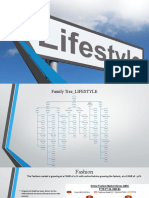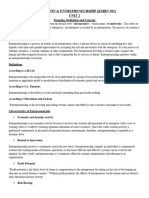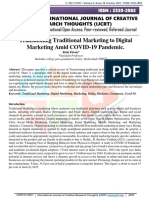RFM Analysis Using Python Spark
Uploaded by
adyatma ardiRFM Analysis Using Python Spark
Uploaded by
adyatma ardiRFM ANALYSIS USING SPARK PYTHON
Achmad Adyatma Ardi1
Programmer, Data Scientist, Engineer
*Corresponding author : achmad541997@gmail.com
Saturday, April 23, 2022
Abstract
With good knowledge and good tools to analyze the data, datas can tell you
everything you want. Programming languages is good one for this purposes. In this
research, I will show you how to visualize data using python. The data set used is
weather data contained 14 variables to analyze. To execute programming statement
we use Jupyter Notebook. Kind of visualization data using seaborn library include :
barplot, displot, joinplot, pairplot, stripplot, swarmplot, boxplot, countplot, pointplot,
lmplot
Keyword : data science, python programming, visualize data, seaborn library,
pandas library, jupyter notebook
Introduction
customers who recently made a
RFM analysis is a marketing purchase will still have the product
technique used to quantitatively rank on their mind and are more likely
and group customers based on the to purchase or use the product
recency, frequency and monetary total again. Businesses often measure
of their recent transactions to identify recency in days. But, depending on
the best customers and perform the product, they may measure it in
targeted marketing campaigns. years, weeks or even hours
RFM analysis ranks each 2. Frequency
customer on the following factors It means the frequency of customer
called (RFM Metrics): transactions. How often did this
1. Recency customer make a purchase in a
It means the freshness of customer given period ? customers who
activity. How recent was the purchased once are often are more
customer’s last purchase ? likely to purchase again.
Achmad Adyatma Ardi
Additionally, first time customers They are your recent customers
may be good targets for follow – with average frequency and who
up advertising to convert them into spent a good amount. Offer
more frequent customers membership or loyalty programs or
3. Monetary recommend related products to
It means the willingness to spend. upsell them become your loyalists
How much money did the or champions.
customer spend in a given period ? 3. New customers
customers who spend a lot of They are your customers who have
money are more likely to spend a high overall RFM score but are
money in the future and have a not frequent shoppers. Start
high value to a business building relationships with these
customers by providing
RFM analysis is a powerful tool onboarding support and special
in marketing that helps marketers offers to increase their visits.
make the best of their advertising 4. At risk customers
budget. Also, nonprofits and charities They are your customers who
can user RFM analysis to find the best purchased often and spent big
donors, for example as those who have amounts, but havent’t purchased
donated in the past are more likely to recently. Send them personalized
donate again in the future. reactivation campaigns to
Instead of simply using an reconnect, and offer renewals and
overall RFM average value to identify helpful products to encourage
the best customers, RFM analysis can another purchase
be used to identify clusters of 5. Can’t lose them
customers with similar values called They are customers who used to
customer segmentation. These are kind visit and purchase quite often, but
of customer : haven’t been visiting recently.
1. Loyalist / Champions Bring them back with relevant
They are the best customers, who promotions, and run surveys to
bough most recently, most often, find out what went wrong and
and are heavy spenders. Reward avoid losing them to a competitor.
these customers. They can become
early adopters for new products Methodology
and will help promote your brand.
2. Potential loyalists RFM analysis scores customers
on each of the three main factors.
Achmad Adyatma Ardi
Generally, a score from 1 to 5 is given,
with 5 being the highest. Various
implementations of an RFM analysis
system may use slightly different
values or scaling.
The collection of three values for
each customer is called an RFM cell.
In a simple system, organizations
average these values together, then sort
customers from highest to lowest to
find most valuable customers. Some
businesses, instead of simply
averaging the three values, weight the
values differently
RFM Dataset Required
To do RFM analysis, the
required data are :
1. SKU – Stock Keeping Unit. A
unique product code
2. OrderNum – order number (i.e.,
transaction id)
3. CustomerID – unique customer id
4. Sale Price – sold price (what the
customer has paid for the item
bought in the order)
5. SKU Description – description of
the product
6. Created On – the date on which the
customer has created the order
7. Category – the category of the
product (SKU). There are consists
of several category based on SKU
Achmad Adyatma Ardi
You might also like
- Jay Abraham - Mastermind Marketing System NOTESNo ratings yetJay Abraham - Mastermind Marketing System NOTES14 pages
- Walmart: Transformational Leadership Is A Leadership Style WhereinNo ratings yetWalmart: Transformational Leadership Is A Leadership Style Wherein3 pages
- Customer Value Propositions in Business Markets PDFNo ratings yetCustomer Value Propositions in Business Markets PDF4 pages
- Benefits of RFM Analysis: Pareto PrincipleNo ratings yetBenefits of RFM Analysis: Pareto Principle6 pages
- Marketing Analytics Anteckningar Och SlidesNo ratings yetMarketing Analytics Anteckningar Och Slides17 pages
- Cross Selling and Upselling Ebook Author Phocas Software Business Intelligence and Data AnalyticsNo ratings yetCross Selling and Upselling Ebook Author Phocas Software Business Intelligence and Data Analytics13 pages
- Method, Manpower, Machine and Materials. Design Process SequenceNo ratings yetMethod, Manpower, Machine and Materials. Design Process Sequence5 pages
- RFM Anlaysis: Applications of RFM AnalysisNo ratings yetRFM Anlaysis: Applications of RFM Analysis2 pages
- Customer Relationship Management Strategies L5No ratings yetCustomer Relationship Management Strategies L523 pages
- A Study On Customer Segmentation Using Recency Frequency and Monetary Analysis On Jivanjor Adhesive Product at BangloreNo ratings yetA Study On Customer Segmentation Using Recency Frequency and Monetary Analysis On Jivanjor Adhesive Product at Banglore9 pages
- Supply Chain Management: Assignment 1 - Nordstrom's Case Study September 19, 2016No ratings yetSupply Chain Management: Assignment 1 - Nordstrom's Case Study September 19, 20165 pages
- Outmarket the Competition: Advanced Marketing Tactics to Drive Growth and ProfitabilityFrom EverandOutmarket the Competition: Advanced Marketing Tactics to Drive Growth and ProfitabilityNo ratings yet
- CHAPTER 3 LESSON 3 (MARKET SEGMENT AND CONSUMER BEHAVIOR)No ratings yetCHAPTER 3 LESSON 3 (MARKET SEGMENT AND CONSUMER BEHAVIOR)6 pages
- CHAPTER 7 AND CHAPTER 8 Retail ManagementNo ratings yetCHAPTER 7 AND CHAPTER 8 Retail Management10 pages
- Customer Needs: Company Skills: Competition: Collaborators: ContextNo ratings yetCustomer Needs: Company Skills: Competition: Collaborators: Context9 pages
- RFM Analysis in R: Math 3201 Datamining FoundationNo ratings yetRFM Analysis in R: Math 3201 Datamining Foundation12 pages
- Sales Process - 7 Steps: R. K Institute of Management & ResearchNo ratings yetSales Process - 7 Steps: R. K Institute of Management & Research25 pages
- The Competitive Profile Matrix (CPM) : Total100% (1)The Competitive Profile Matrix (CPM) : Total2 pages
- Unit 2 Innovation & Entrepreneurship KMBN302No ratings yetUnit 2 Innovation & Entrepreneurship KMBN30228 pages
- Digital Marketing Strategies To Increase Online Business Sales Through Social MediaNo ratings yetDigital Marketing Strategies To Increase Online Business Sales Through Social Media6 pages
- HMKT100 1 Jan Jun2024 FA1 Memo DA V2 22082023No ratings yetHMKT100 1 Jan Jun2024 FA1 Memo DA V2 2208202320 pages
- Transitioning Traditional Marketing To Digital Marketing Amid COVID-19 PandemicNo ratings yetTransitioning Traditional Marketing To Digital Marketing Amid COVID-19 Pandemic4 pages
- Assessment 1: Individual Secondary Research Report: Course Code and Name: Lecturer: Name: Student's IDNo ratings yetAssessment 1: Individual Secondary Research Report: Course Code and Name: Lecturer: Name: Student's ID19 pages
- Zimbabwe Ezekiel Guti University: 1. Nature of IMCNo ratings yetZimbabwe Ezekiel Guti University: 1. Nature of IMC4 pages
- Demystifying The Influence of CSR Perception On The Purchase Intention of Generation Z in Fast Food IndustryNo ratings yetDemystifying The Influence of CSR Perception On The Purchase Intention of Generation Z in Fast Food Industry20 pages
- A Researcher Estimated That The Price Elasticity O...No ratings yetA Researcher Estimated That The Price Elasticity O...1 page

























































































